How to Install a Paver Patio in 6 Easy Steps
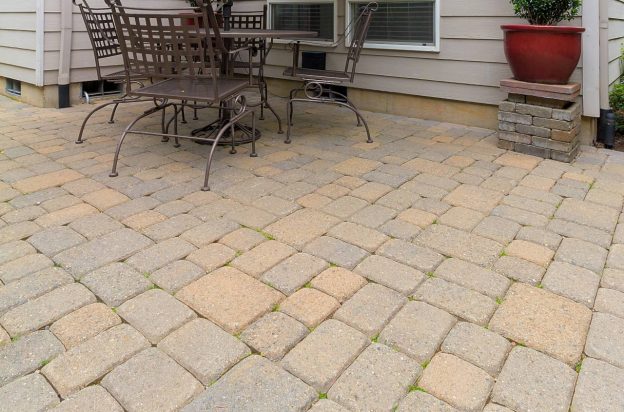
Paver patios are a beautiful alternative to a concrete patio or a deck. They are popular, attractive, affordable, durable, and require little maintenance.
Pavers are not difficult to install once you get the method down, and it’s possible to install your patio in a weekend. In addition, pavers can also be used on driveways, walkways, and paths if you want to create a unified look for your landscaping.
Prepare for your patio installation using our installation guide below. The average cost to have a paver patio installed is $8 – $20 per square foot. You can save some money by doing the expensive work yourself.
Keep in mind that you will need some specialized tools for the job, which can increase costs. If possible, rent these tools from your local home improvement store to keep costs down.
Materials Needed to Install a Paver Patio
Be sure to prepare and get the right material to install your patio.
You’ll need the following materials:
- Gravel base
- Sand
- Pavers
- Polymeric sand
Tools Needed to Install a Paver Patio
There are several tools required to install a patio.
You’ll need the following tools:
- Tape measure
- Level
- Mason line, stakes, and a level
- Shovel
- Rake
- Wheelbarrow
- Push broom
- Plate compactor
- Masonry saw or wet saw
- Edging and spikes
- Three 2×4 boards (to screed the sand)
- Marking paint
- 2 x 6 board for leveling the pavers
- Rubber mallet
- Hearing and eye protection
- Dust mask or respirator
As an Amazon Associate, we may earn commissions from qualifying purchases from Amazon. Learn more
Patio Layout and Planning
Before you begin the installation, you’ll need to plan thoroughly and lay out the area. Before you do any digging, call to have buried utilities, such as electrical, gas, cable, phone, and water lines marked out. This essential safety step is often a free service and usually requires a single call.
With buried utilities marked, you can start to lay out where the patio will go and mark out the boundaries. Use marking paint to delineate the perimeter. Because marking paint can be washed away, drive stakes into the ground along the line you marked at regular intervals, and run masonry string along them so the line will be permanent.
To lay out curves, you can use a garden hose to lay out the curve, then mark the patio using paint when the curve is just right.
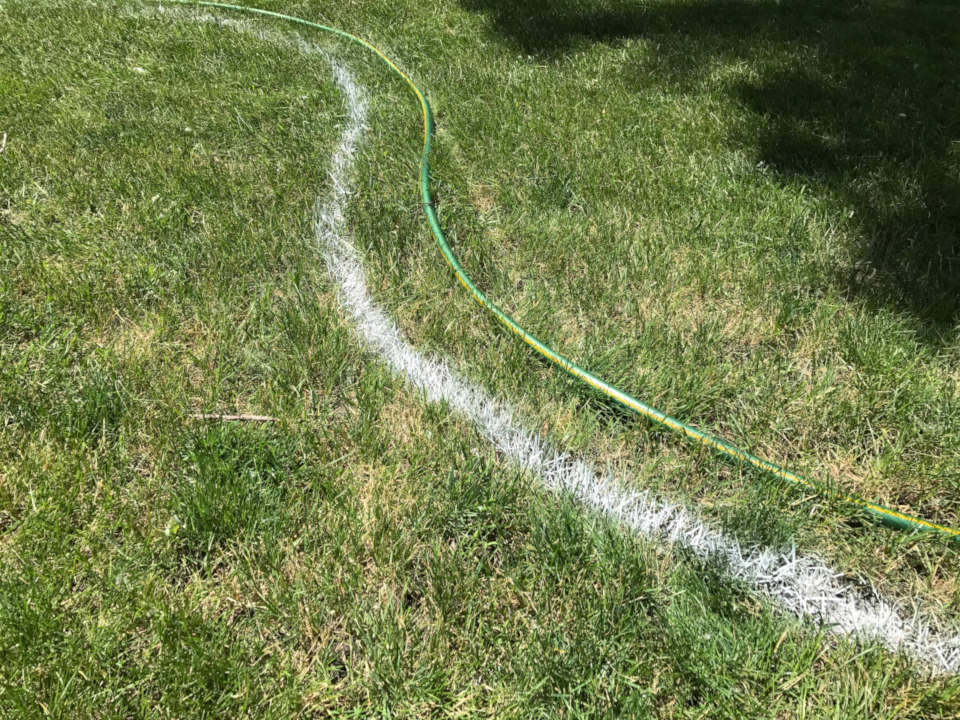
Patios need to pitch away from your home at the rate of 1/8″ for every running foot. This means that for every 8′ of patio moving away from your home, the pitch needs to drop 1″.
So a patio that extends 20′ from your home needs to slope 2 1/2″ over the course of those 20′. You can adjust your masonry string to indicate this drop by having it drop along the same rate.
For example, if it starts at 6″ above the ground at the end of the patio closest to the house, it should finish 3.5″ above the ground at the other end.
Once you have determined the right size for the patio, calculate how many pavers you need to fill the space. Get the length and width of the area to calculate the square footage, as well as the size and type of the pavers. If you plan on laying the pavers in a pattern, determine this as well.
Use our paver calculator to easily find the amount of pavers you need for the space. Estimate the amount of gravel and sand you will need for the base of the patio using our paver base calculator.
Excavate the Patio Area
You will need to determine the final height of the patio. Start by finding the thickness of the paver, then add 1″ for a layer of sand, and 4″ to 6″ for a layer of compacted gravel or crushed stone. Some paver manufacturers will recommend a specific base thickness, so always check before ordering. Remember that you must call to have utilities marked before you dig.
Use the mason string from the layout to determine the depth of soil to remove. Dig the area using a shovel, then tamp to compact the soil.
Your patio area should be about 6-11″ deep, depending on your pavers’ thickness.
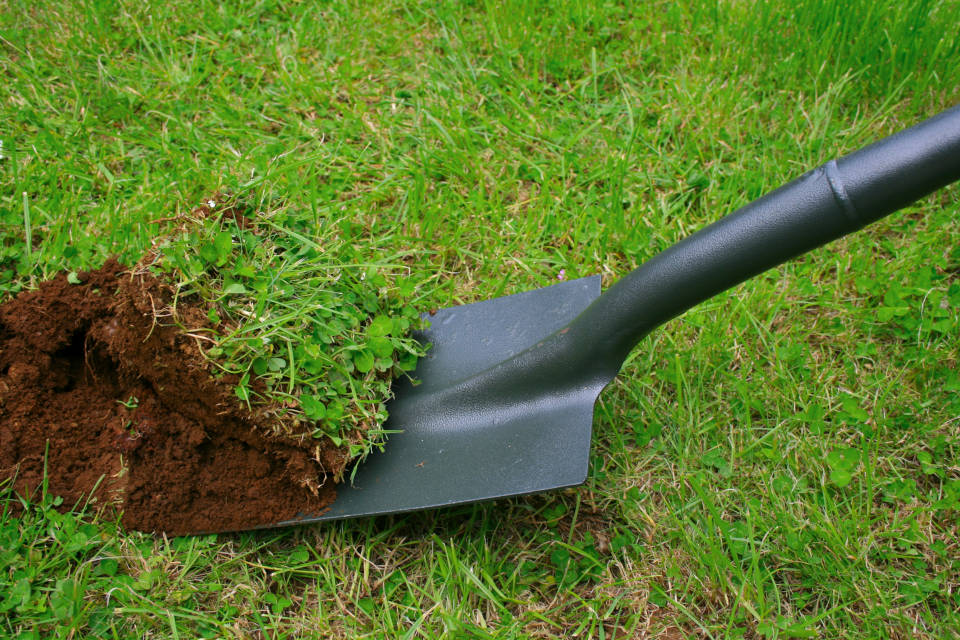
Add the Patio Base
After the base has been dug, add the gravel. Keep in mind that the final gravel depth is measured after it is compacted; the gravel may appear too high when it is first added.
Compact the gravel patio base using a tamper or a plate compactor. You may need to rent the compactor, but for even a moderate-sized patio, it will be more effective than a hand tamper and save hours of back-breaking labor.
This step is crucial to prevent the patio from settling and allow for proper drainage. Verify that the surface is level and at an equal depth below the mason string, adding additional gravel to low spots.
Voids can sometimes form during this stage, so it is common to need to add additional gravel in areas to ensure everything remains level. Always compact the added gravel.
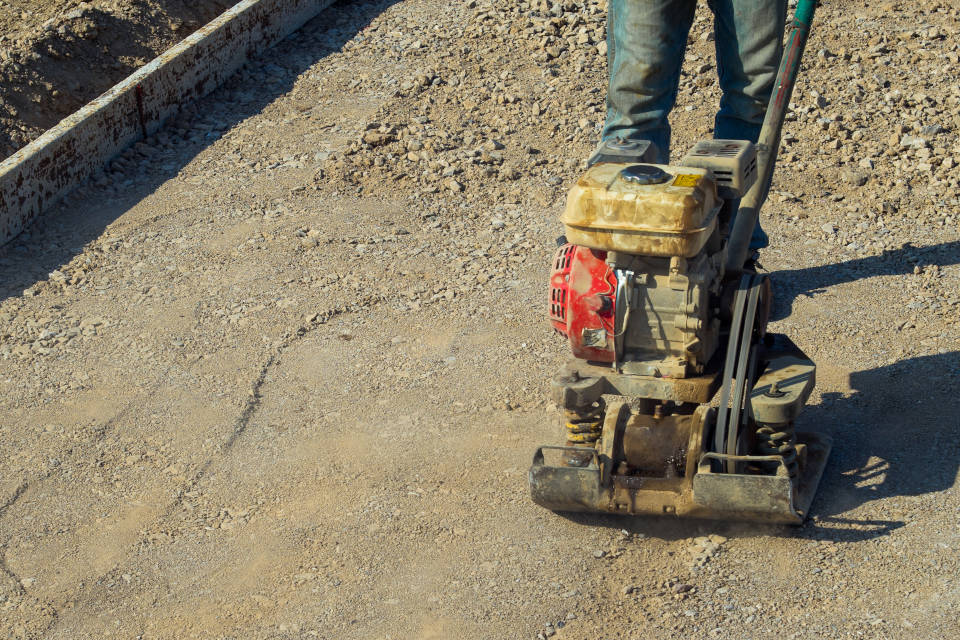
After the gravel base is level and compacted, add a layer of sand, then compact again. This layer should be a precise depth below the mason line and will be the final layer that you’ll set the pavers onto. This layer must be perfectly flat, and 1-inch thick after compacting.
Many people recommend screeding the sand by embedding a few 2x4s or pipes in the sand, then pulling a board along those to level the surface. Whatever your approach, the surface needs to be perfect, or you will see imperfections in the patio.
Install Pavers
Before you start installing the pavers, take the time to create a dry layout nearby. In a dry layout, you’ll take the time to arrange the pavers beside one another without disturbing the final installation space.
This step is important if you have pavers with varying colors, as it lets you blend the colors before you install so that they can vary evenly over the installation. A dry layout also lets you become comfortable with any patterns you are installing.
Once you get comfortable with handling the pavers and mixing colors, take another few minutes to practice making cuts. Cutting the pavers is often necessary for patterns and edges; make a few practice cuts to get comfortable before you begin the installation.
Install the pavers for the patio by placing them evenly in the sand, making sure the surface is flat. Set them tightly, but not so tightly that each paver displaces sand as this can cause the surrounding pavers to rise.
This step will go fast. When you need to cut the pavers, consider using a masonry blade attached to a circular saw, which you can usually find at your local home center.
You can also use a tile wet saw with a diamond-tipped blade. This will help cut down on dust, which is important if you are cutting any material that may contain silica. If you cut the materials with a masonry blade on a circular saw, always wear a dust mask or respirator, and always wear eye protection.
Your pavers need to be set at the same distance from one another. The space left between the pavers is called the joint, and it’s necessary to help protect the edges of the pavers. Use the recommended joint size for each paver type; joint spacers are available to fit between the pavers as you lay them to ensure this stays even if necessary.
If you are laying irregular pavers or large pavers, keep in mind that a condition known as lippage may occur. This is when a corner of a paver sticks up above the others. To help avoid lippage, lay a 2×6 board on top of a row of pavers and hit the board lightly from end to end with a rubber mallet.
This will help drive the pavers evenly into the sand, and any that may be slightly thicker or irregular will level out with the others. Be sure not to hit the pavers directly or too hard, as this could displace the sand.
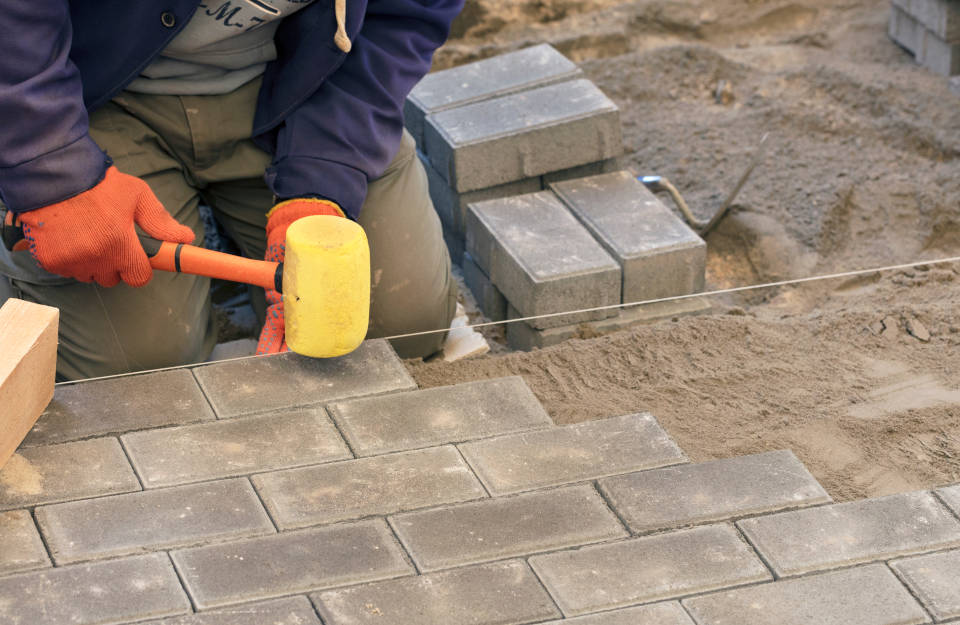
Add Sand to the Joints
At this point, your pavers should be set, and the patio should look beautiful. It is essential to add a layer of polymeric or fine, dry paver sand in the joints.
This locks the pavers together, so they don’t move and prevents weed growth. Sweep the sand into the joints and remove any excess.
After you’ve applied the sand, use a hose and garden nozzle to wash the surface. This cleans the pavers and starts a chemical reaction in the polymeric sand, causing it to fuse together.
Keep in mind that if you have too much sand on top of the pavers before you do this step, it can cause the polymeric sand to form a crust that hardens on the pavers. To prevent this, sweep the sand well into the joints.
Sweep from different angles and directions evenly over the entire patio. This will help ensure that the sand gets well packed into the joints, and that little to no sand remains on the pavers.
Our polymeric sand calculator will provide an estimate for how much of this you need to finish the patio.
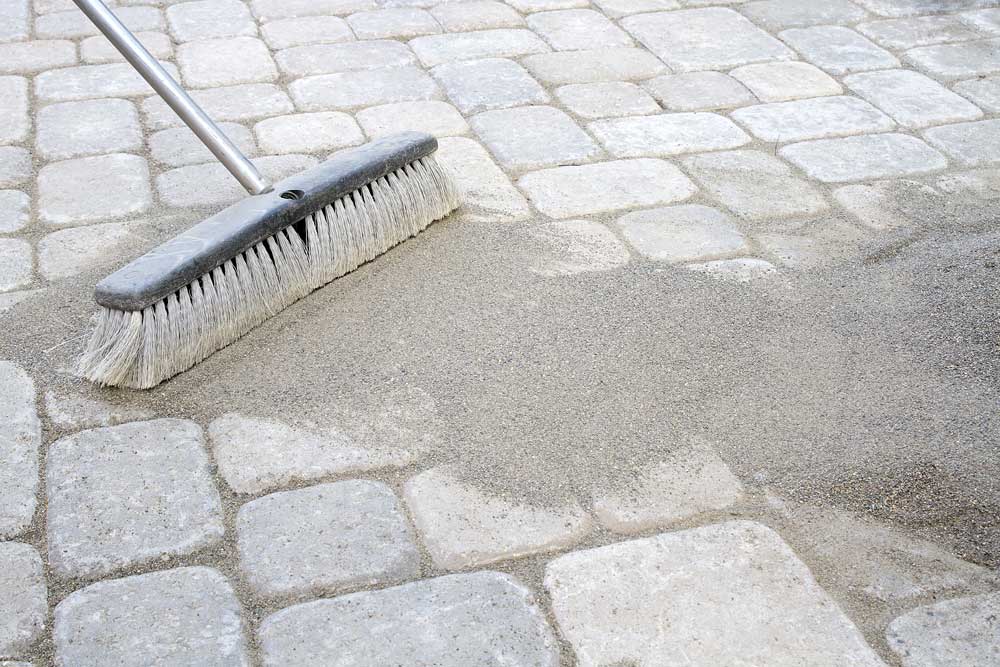
Seal the Patio
After you’ve completed the jointing sand, it’s time to seal the patio. This enhances the beauty of the patio and prevents staining of the pavers. Sealer is usually applied using a paint roller.
Make sure you choose a sealer designed for the material your pavers are made from; brick pavers do not require a sealer, but concrete does, as do some types of stone. Choose an impregnating sealer with a silicone base, as this will hold up best outdoors.
Apply the sealer in overlapping strokes, and do not allow it to puddle on the pavers. Depending on the type of sealer you choose, you may need to wipe or buff it away after about 10 minutes using a soft cloth.
Installing a paver patio yourself is an affordable way to add beauty to your yard! The right planning and preparation will make the installation go smoother, and the end result longer lasting.


